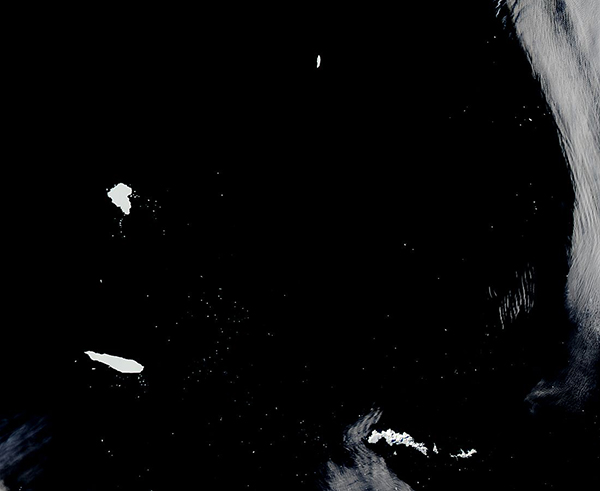Images
March 30, 2018 - Icebergs B15T and C28B near the South Orkney Islands
Tweet
In late March 2018 a long-lived pair of icebergs continued their drifting journey across the South Atlantic Ocean. On March 26 the Moderate Resolution Imaging Spectroradiometer (MODIS) aboard NASA’s Aqua satellite acquired this true-color image of B15T and C28B floating in open water near Coronation Island, part of the South Orkney Islands.
C28B appears roughly square and floats to the north of the more elongated B15T. B15T, the older of the two ‘bergs, just turned 18 year old. It is a remnant of one of the largest icebergs ever observed, B15, which calved from the Ross Ice Shelf in late March, 2000. The original iceberg was almost the size of the state of Connecticut. B15T is the largest of the remnants of B15.
In February of 2010, a fragment of and iceberg (B-9) drifted into the floating tongue of the Mertz Glacier in East Antarctica. The collision fractured off a large piece of the glacial tongue, giving birth to Iceberg C28. As C28 began to break apart, C28B was formed.
Many icebergs get caught up in the currents circling Antarctica and then eventually spin off to the north, where they break up and melt. However, icebergs that stay trapped in the cool waters close to Antarctica can persist for decades.
Image Facts
Satellite:
Aqua
Date Acquired: 3/26/2018
Resolutions:
1km (15.4 KB), 500m (49.1 KB), 250m (123.1 KB)
Bands Used: 1,4,3
Image Credit:
Jeff Schmaltz, MODIS Land Rapid Response Team, NASA GSFC
Tweet
In late March 2018 a long-lived pair of icebergs continued their drifting journey across the South Atlantic Ocean. On March 26 the Moderate Resolution Imaging Spectroradiometer (MODIS) aboard NASA’s Aqua satellite acquired this true-color image of B15T and C28B floating in open water near Coronation Island, part of the South Orkney Islands.
C28B appears roughly square and floats to the north of the more elongated B15T. B15T, the older of the two ‘bergs, just turned 18 year old. It is a remnant of one of the largest icebergs ever observed, B15, which calved from the Ross Ice Shelf in late March, 2000. The original iceberg was almost the size of the state of Connecticut. B15T is the largest of the remnants of B15.
In February of 2010, a fragment of and iceberg (B-9) drifted into the floating tongue of the Mertz Glacier in East Antarctica. The collision fractured off a large piece of the glacial tongue, giving birth to Iceberg C28. As C28 began to break apart, C28B was formed.
Many icebergs get caught up in the currents circling Antarctica and then eventually spin off to the north, where they break up and melt. However, icebergs that stay trapped in the cool waters close to Antarctica can persist for decades.
Image Facts
Satellite:
Aqua
Date Acquired: 3/26/2018
Resolutions:
1km (15.4 KB), 500m (49.1 KB), 250m (123.1 KB)
Bands Used: 1,4,3
Image Credit:
Jeff Schmaltz, MODIS Land Rapid Response Team, NASA GSFC




